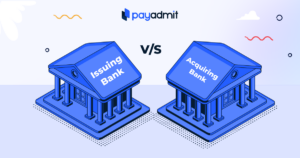The annual number of cashless payments has recently grown from 426 to 468 billion globally. When customers like a product, they place it in the shopping cart, proceed to the checkout page, and pay with a credit card or other banking method. The funds are, then, transferred from the purchaser to the seller immediately. Processing an online payment involves two parties: the acquirer bank and issuer bank. In this article, we will explain their differences in actions. Let’s dive in!

The annual number of global cashless payments has risen from 426 to 468 billion. When customers pay online, funds are transferred instantly from the issuing bank (payer’s bank) to the acquiring bank (seller’s bank).
The issuing bank is called the financial institution on the customer’s side. It is responsible for issuing credit and debit cards based on Visa, MasterCard, American Express, and other payment integrations. The issuer operates as a middleman between the customer and the card network.
How does it work?
The issuing bank ensures the customer has sufficient funds on the card. If yes, the issuer approves the transaction and authorizes the acquiring bank to complete the purchase.
The acquiring bank is the financial institution on the merchant’s side. It takes responsibility for processing credit and debit card transactions between the customer and the seller. Due to the high risk of fraud and data breach, the acquirer has to comply with strict regulations established by the Payment Card Industry Data Security Standard (PCI DSS).
The clear pricing model allows merchants to see exactly how much they are paying to the acquirer and how much to the card network. Special fees are shared with the issuer, which allows them to make revenue without charging their customers.
How does it work?
The acquiring bank requests authorization from the issuing bank when the customer is making an online purchase. This request is initiated via a credit card network. The acquirer can complete a product purchase upon the issuer’s approval.
The acquirer and issuer depend on each other, despite having distinct responsibilities in payment processing. Let’s explore the difference between an acquiring bank and an issuing bank.
Acquirer:
Issuer:

The acquirer and issuer banks rely on each other to ensure smooth payment processing. However, they have distinct responsibilities: the acquirer manages merchant accounts and transactions, while the issuer authorizes payments and issues credit or debit cards.
The issuer and acquirer are equally involved in remote sales. The table below outlines their roles and responsibilities in e-commerce.
|
Issuer |
Acquirer |
|
Manages credit card applications |
Clarifies rules and requirements for merchant accounts |
|
Approves or declines customer transactions |
Sends authorization requests |
|
Issues credit and debit cards to verified customers |
Transfers funds into your account upon successful payment processing |
|
Releases funds to the acquirer upon transaction approval |
Receives chargeback notifications and debits customer accounts |
|
Takes control over debit or credit accounts |
Takes control over merchant accounts |
|
Initiates the refund on the customer’s behalf |
Allows you to make a profit from purchases made with credit and debit cards |
|
Allows customers to make online payments |
Track merchant account activity (deposits, withdrawals, fees, etc.) |
Now that you know the difference between an acquiring bank (Chase, Global Payments, and Wells Fargo) and an issuing bank (Capital One, Bank of America, and Chase), it’s good to have a real example. Please note that the issuer and acquirer can be the same bank. Let’s put it in a simple scenario:
The company receives the payment for the bag, and you eventually pay back your bank based on your credit card agreement.

An acquiring bank handles the merchant’s payment processing, while an issuing bank authorizes the buyer’s transaction. For instance, when you buy a bag online, the store’s bank requests authorization from your credit card’s bank.
The acquirer and issuer in the banking payment process play standard roles across all card brands. In certain situations, additional responsibilities need to be taken. Below, you can check the transaction flow and learn the chargeback definition.
The customer purchases goods by paying with a credit or debit card. The merchant’s point-of-sale system (e.g. stripe terminal) or payment gateway accepts the card, encrypts the transaction data, and transfers encrypted data to the acquiring bank through the credit card network. The acquirer sends an authorization request to the issuing bank, ensuring the customer meets all the eligibility criteria to make the purchase.
The acquisition bank sends transaction data to the issuing bank through the credit card network. The issuer reviews the cardholder’s account status and either approves or declines the transaction.
An authorization response from the issuer will be approved if:
An authorization response from the issuer will not be approved if:
A transaction must be settled upon approval. Settlement is defined as the process of transferring funds from the customer’s account to the merchant’s account, with the reduction of interchange and processing fees. Some merchants settle all transactions by the end of the business day. For example, restaurants may delay the settlement until the moment of receiving the tips. The settlement completes the transaction unless disputed by the customer. The issuance bank sends funds to the acquiring bank through the credit card network immediately.
The acquiring vs issuing bank may work together to manage chargebacks. This means that the customer can contact the issuing bank to dispute a transaction. The issuer makes a conditional refund and sends a chargeback notification to the acquirer, which then debits the merchant’s account. Unlike a standard transaction, the issuer receives funds, and the acquirer remits them.
A chargeback can be disputed if found invalid. You submit a rebuttal to the acquiring processor. If validated, your merchant account is credited, and the response is sent to the issuing processor for review. The issuer then decides whether your claim matches the initial dispute, potentially debiting the customer’s account again.
Acquiring vs issuing banks have the same unique features when processing international operations. Credit card networks are not available in some countries. So the customer may find their cards being unaccepted abroad.
The merchant needs to confirm that their payment gateway API accepts international transactions in different industries. This is especially the case when they plan to sell their goods to consumers in different parts of the world. Most such purchases are made through mobile devices, with the whole process being fully automated.
Understanding the roles of acquiring and issuing banks is crucial for setting up your business and accepting payments. Make sure to partner with a payment service provider that offers built-in acquiring services, enabling smooth transactions around the clock. With the acquiring bank vs issuing bank example in mind, you can connect with the customer faster and easier.